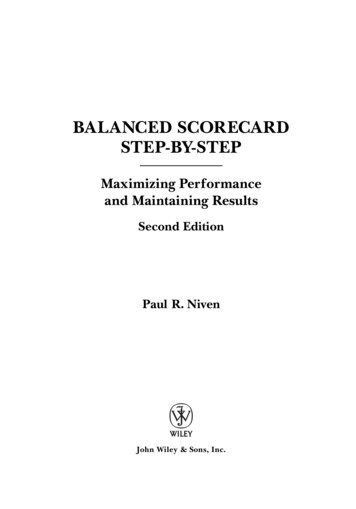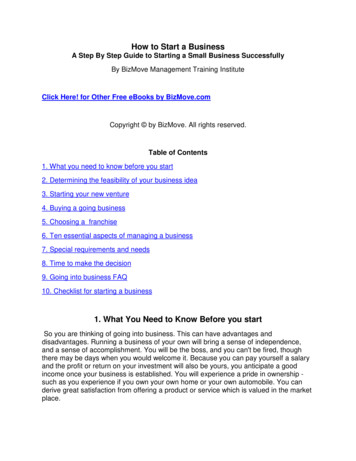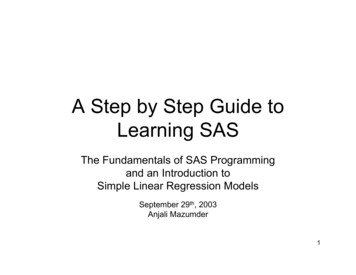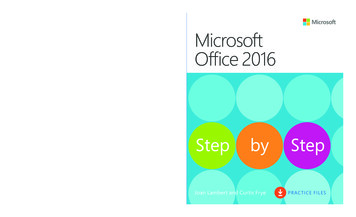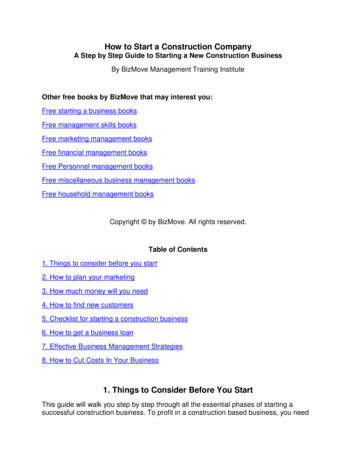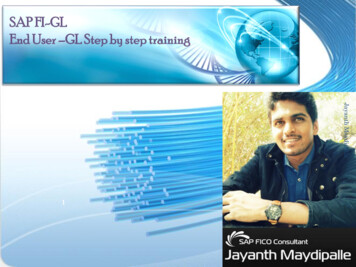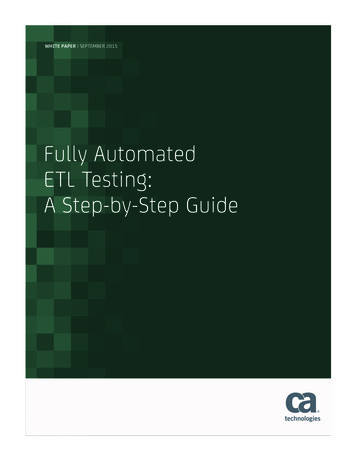
Transcription
mplementationwww.npc.org.myLatest Publication
NATIONAL PRODUCTIVITY CORPORATIONAll rights reserved.No part of this publication may be reproduced or distributedin any form or by any means, or stored in a data base or retrievalsystem, or transmitted in any form or by any means, electronic,mechanical, photocopying, recording, or otherwise,without the prior written permission of theNational Productivity Corporation.2005Published by:National Productivity Corporation(Perbadanan Produktiviti Negara)P.O. Box 64, Jalan Sultan46904 Petaling JayaMalaysiaTel: 03-79557266 / 79557050Fax: 03-79578068 / 79551824http://www.npc.org.myISBN 983-2025-12-5Price: RM 30.00
5S: GuidebookStep-by-StepImplementationPush for Productivity, Go for Quality.
NATIONAL PRODUCTIVITY CORPORATIONVISIONTo be a world-class productivity and quality institution.MISSIONTo contribute significantly towards the productivity and qualityenhancement of the nation for balanced economic growth.OBJECTIVESTo provide input in the area of productivity and qualityfor policy formulation and planning.To enhance organisational and human resourcesdevelopment towards culture of excellence.To lead the productivity and quality movement.
FOREWORDThe global economic challenges have changed the perspectivesof working culture towards excellent working performance withthe adoption of best practices. One of the tools to achieveorganisational excellence is the 5S management techniques.5S management techniques have contributed significantly toimprove internal efficiencies, operational effectiveness and fosteron time delivery system to the delight of customers. To achievethis, organisations should integrate 5S activities into their businessfunctions as their organisational culture.National Productivity Corporation (NPC) has been the leadingorganisation and disseminator of 5S best practices. It hascontinuously been improving 5S activities as a more effectiveapproach in business operations.I believe this guidebook would serve as a quick reference for 5Simplementation and will be of benefit to all industries that strive toenhance continuous improvement for competitiveness.Nik Zainiah Nik Abd RahmanDirector GeneralNational Productivity Corporationi
PURPOSE OF GUIDEBOOK5S: Step-by-Step Implementation guidebook is intended to explainthe 5S concept in a simplified format so as to serve as a quick5S Implementation reference for everyone.It is all about knowledge transfer to facilitate the on-going learningprocess that provides you with practical guidelines and actualexamples from leading organisations on how the 5S managementtechniques work.This guidebook offers you sufficient details on how organisationsshould integrate each ‘S’ into their business function as theirorganisational culture to enhance continuous improvement.Finally, an effective way to use this guidebook is to read anddiscuss it in group-learning sessions with the guidance of the 5SFacilitator.ii
contents ForewordiPurpose of Guidebook5S Management TechniquesIntroductionUnderstanding 5SSORTSET IN ORDERSHINESTANDARDISESUSTAINWhy 5S?What is Not 5S?Benefits of 5S ImplementationKeys to 5S successHow to Initiate 5S ImplementationPLAN - DO - CHECK - ACTRoadmap To 5S ImplementationiiPhase 1: Guidelines for 5S PreparationStep 1: Formation of 5S Council5S Steering, Training, Promotionand Audit CommitteeRoles and ResponsibilitiesStep 2 : Set-up of 5S ZonesStep 3 : 5S TrainingStep 4 : 5S Declaration/LaunchExamples of 5S PreparationPhase 2: 5S : Step-by-Step ImplementationGuidelines for Practising SORTDescriptionGuidelinesPotential Impact and Actual Examples 123456799910111315161718192026
Guidelines for Practising SET IN ORDERDescriptionGuidelinesPotential Impact and Actual Examples31Guidelines for Practising SHINEDescriptionGuidelinesPotential Impact and Actual Examples36Guidelines for Practising STANDARDISEDescriptionGuidelinesPotential Impact and Actual Examples39Guidelines for Practising SUSTAINDescriptionGuidelinesPotential Impact and Actual Examples43Phase 3: 5S Self-Assessment and 5S CertificationObjectivesGuidelines for 5S Self - Assessment5S Audit Checklists5S Audit Summary Sheet3S & Excellent Stickers5S Certification4647484951Phase 4: KPIs for Continual ImprovementImportance of KPIsAdapting KPIs52Conclusion535S Quick Self-Assessment545S Certification Enquiries56
5S Management Techniques INTRODUCTIONToday, it is increasingly recognised that 5S management techniquesenhance productivity and competitiveness. In order to become a WorldClass Gemba, an organisation has to go through a continuous andsystematic process to:Identify, reduce and eliminate wasteEnhance teamworkEnhance operation efffectiveness in a better working environmentForm the basic advanced model for Productivity and QualityImprovement.As each 5S management techniques begins with an S, this approachhas been named 5S.UNDERSTANDING 5S5S is a management tool from Japan, that focuses on establishing aquality environment in the organisation, ensuring adherence tostandards and in the process, fosters the spirit of continualimprovement.It focuses on five management techniques that are the foundationfor any organisation’s competitive initiative. The 5S are defined withexamples as shown on page 2.1
2UNDERSTANDING 5S
5S Management Techniques SORTTo sort and systematically discard itemsthat are not needed in the workplace.3
5S Management Techniques SET IN ORDERTo arrange necessary items in a neatand systematic manner so that they canbe easily retrieved for use and to returnafter use.4
5S Management Techniques SHINETo clean and inspect the workplacethoroughly so that there is no dirt onthe floor, machines and equipments.5
5S Management Techniques STANDARDISETo maintain a high standard of workplaceorganisation by keeping everything cleanand orderly at all times.6
5S Management Techniques SUSTAINTo train people to practise the 5S systemcontinuously so that it becomes habitualand ingrained in the culture of theorganisation.7
5S Management Techniques 5S POSTERS1.SORT2.SET IN ORDERTo sort and systematically discarditems that are not needed in theworkplace.To arrange necessary itemsin a neat and systematic mannerso that they can be easily retrievedfor use and to return after use.5.SUSTAINTo train people to practise the 5S systemcontinuously so that it becomes habitualand ingrained in the culture of theorganisation.4.STANDARDISE3.SHINETo maintain a high standardof workplace organisationby keeping everything cleanand orderly at all times.5STo clean and inspect the workplacethoroughly so that there is no dirt onthe floor, machines and equipments.IS FUNDAMENTAL TOPRODUCTIVITY IMPROVEMENT5S a d a l a h a s a ske p a d apeningkatanPproduktivitiPdan sih8
5S Management Techniques WHY 5S ?The 5S concept is easy for everyone to understand because:It does not require the understanding of difficult terminologies.It is simple, driven by logic and natural to human behaviour.It is within the reach of all type and size of industry ororganisation.WHAT IS NOT 5S ?A housekeeping exerciseA way to blame people for defectsA way to force people to do their workA way to make people work harder and fasterA monthly or yearly flavour e.g. Quality MonthBENEFITS OF 5S IMPLEMENTATIONToday, many organisations have implemented the 5S system withastonishing results as voiced by our customers, the CEO’s and MDs ofthe Malaysian National 5S Award Winners:“We have not seen any approach to improvement that isSIMPLER or more POWERFUL that can beimplemented at LOWER COST”The benefits are :Workplace becomes cleaner and better organised.Shopfloor and office operation becomes safer.Visible results enhance the generation of more and better ideas.9
5S Management Techniques Lead-time reducedChangeover time reduced by streamlining operations.Breakdowns and minor stops eliminated on production lines.Defects reduced by mistake proofing.Clear methods and standards are established.In-process inventory is reduced.Space usage is improved.Customer complaints are reduced.KEYS TO 5S SUCCESSIn order for the 5S system to be successful, the mostimportant factor is the commitment, participation and involvement . Generally, 5S activities should be carried outsystematically as follows:Visit 5S model companies for continual improvement.Train everyone adequately on 5S Practices.Promote 5S Campaign.Plan systematic approach following thePlan-Do-Check-Act (P-D-C-A) Cycle.Practise Performance Measurement and Reward System.10
5S Management Techniques HOW TO INITIATE 5S IMPLEMENTATIONThe 5S approach outlined in this guidebook is a simple and systematicmethodology which can be introduced and implemented in any sizeand type of organisation.To start the 5S: Step-by-Step Implementation, each phase must bethoroughly analysed and addressed using the P-D-C-A Cycle and 5W2Happroach as follows:PLANPreparation:Provide training and education for everyone.Form 5S Council.Set-up 5S Zones.Determine 5S objectives, goals and implementation phases.Plan 5S action plan and 5S Launch.DOSort:Identify what is necessary.Set in Order:Define what and how to arrange.Shine:Identify dirt sources.Identify root causes.Take action to eliminate dirt sources and root causes.11
5S Management Techniques Standardise:Who is responsible ?What actions to take to maintain the desired condition ?When must those actions be taken ?Where must they apply ?What procedures need to be followed ?Sustain:Everyone understands, obeys and practises the rulesand proceduresContinual efforts at sustaining the desired conditionCHECKAssessment:Conduct Internal 5S Audit.Benchmark within the department and with other organisations.Ensure the established 5S procedures are followed throughACTContinual Improvement:Develop 5S practices into a HABIT.Compare actual goals with set goals.Reward and recognise efforts of staff.Register 5S Certification.Participate in National 5S Competitions.Review Plan-Do-Check-Act Cycle.To ensure successful 5S Implementation, each phase must proceedaccordingly as illustrated in the ROADMAP TO 5S IMPLEMENTATION.12
5S Management Techniques ROADMAP TO 5S IMPLEMENTATIONImproving organisation performance is an ongoing challenge andorganisations benefit best from a holistic approach, and hereis an extremely useful ROADMAP TO 5S IMPLEMENTATION.(See page 14) It provides an excellent framework for establishing:The fundamental process for Productivity and Quality ImprovementsA firm foundation for Continual ImprovementBest PracticesKey Performance ResultsPHASE 1 and 2 are the ENABLERS. PHASE 3 and 4 are the actualRESULTS achieved. After each cycle review:The phase which require improvementThe approaches which will impact on the resultsThe self-assessment to gauge the effectiveness of actions takenTake five minutes to jot down your answers:What are some of the benefits you might experiencefrom implementing 5S in your workplace ?13
14PHASE 1PREPARATIONPLANENABLERSPHASE 2DOPHASE 3RESULTSSELF-ASSESSMENTAND5S CERTIFICATIONCHECKCONTINUAL CREATIVITY AND INNOVATIONROADMAP TO 5S IMPLEMENTATIONPHASE 4CONTINUALIMPROVEMENTACT
Phase 1: Guidelines for 5S Preparation STEP 1: FORMATION OF 5S COUNCILObjectives:To enhance total participation at all levels of employees and develop acontinuous improvement culture and best performance spirit in theteams.5S Council5S Council (See page 20 & 21) comprises the following:5S Steering CommitteeManaging Director as AdvisorGeneral Manager as ChairmanHead of Departments as Facilitators5S Training Committee5S Promotion Committee5S Audit CommitteeThe 5S Steering Committee are responsible for developing theimplementation plan, and the selection of team members is to be basedon ability, organisational representation and expertise.The functionsof the Training Committee, Promotion Committee and the AuditCommittee is as shown on page 22 & 23.5S implementation responsibilities are to be distributed throughout theorganisation. Every member must know their own 5S responsibilitiesand perform accordingly. It is the duty of the Chairman toadminister accountability for each of the responsibilities, as outlinedbelow:Appoint:5S Coordinator5S Facilitators from each department5S Leaders from each zone15
Phase 1: Guidelines for 5S Preparation ROLE AND RESPONSIBILITIES OF:5S Chairman:Communicates with everyone involved.Ensures total organisation participation.Supports 5S implementation activities.Establishes accountability for assigned responsibilities.5S Coordinator:Communicates with everyone involved.Facilitate work group implementation activities.Motivate and monitor implementation activities.Ensure total organisation participation.Act as a resource for information.5S Facilitators:Support 5S implementation.Communicate with everyone involved.Motivate work groups.Ensure employee implementation plan.Monitor measurement systems.5S Leaders:Participate in work group implementation process.Communicate with everyone involved.Monitor progress of group activities.Employees’ responsibilities:Participate in group activities with full commitment16
Phase 1: Guidelines for 5S Preparation STEP 2: SET-UP 5S ZONES5S Coordinat
5S Audit Checklists 47 5S Audit Summary Sheet 48 3S & Excellent Stickers 49 5S Certification 51 Phase 4: KPIs for Continual Improvement 52 Importance of KPIs Adapting KPIs Conclusion 53 5S Quick Self-Assessment 54 5S Certification Enquiries 56. 1 INTRODUCTION Today, it is increasingly recognised that 5S management techniques enhance productivity and competitiveness. In order to become a

